Introducing Openchat: a Powerful Open-source Language Model for Your Business
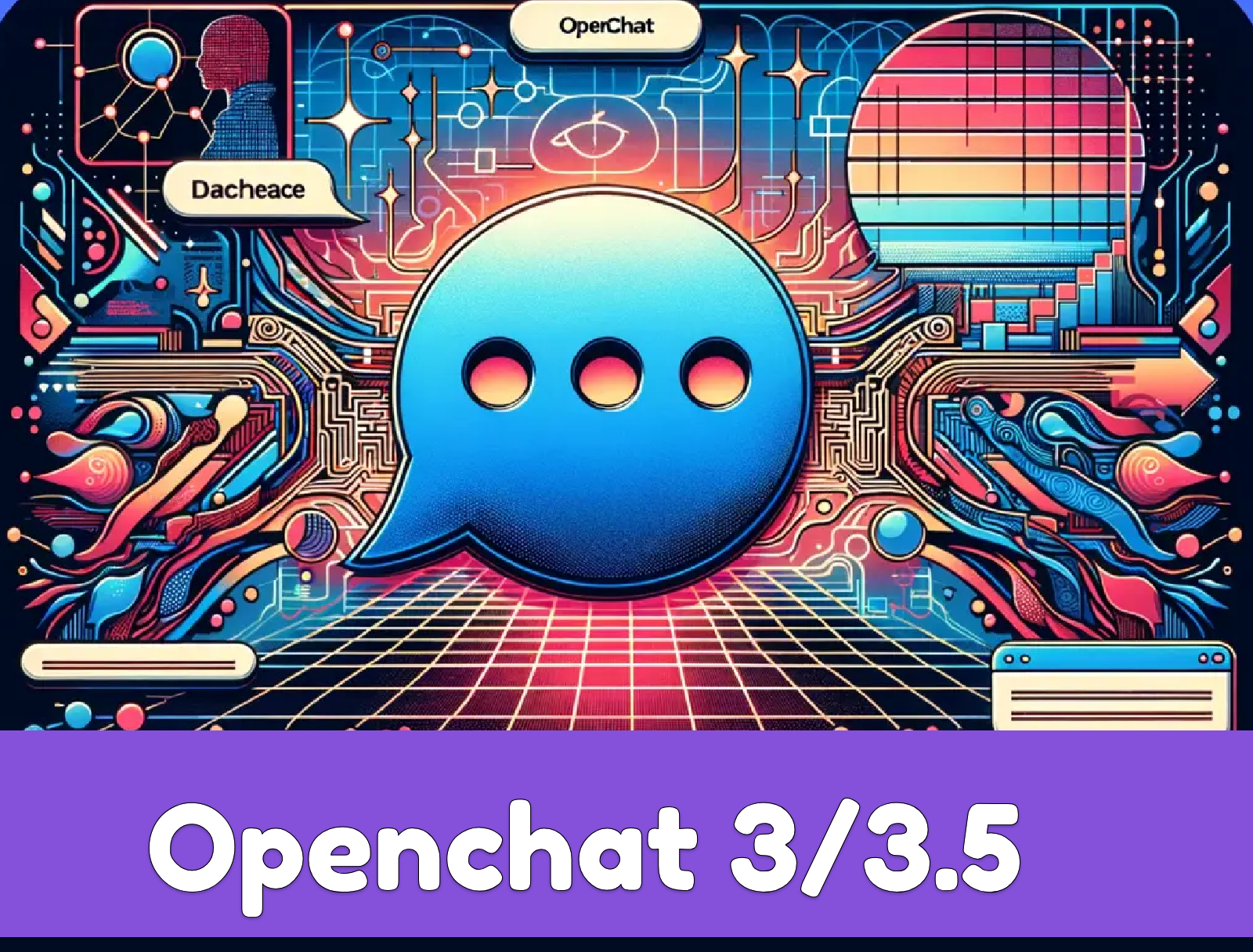
Dive into our blog to know about the advantages of Openchat, and take in more information about open-source language models.
Introduction
Language models have become an essential tool for businesses in the digital age. These models use artificial intelligence (AI) to understand and generate human-like text, enabling businesses to automate tasks, enhance customer service, and streamline operations. One such powerful language model is Openchat.
Openchat is an open-source language model that is designed to be integrated into businesses. It leverages advanced AI technology to understand natural language and generate meaningful responses in real-time. This allows businesses to automate tasks, provide personalized customer service, and improve overall efficiency.
With Openchat, businesses can harness the power of AI to enhance their operations and stay ahead in today’s competitive market. It offers a range of capabilities, including natural language processing, sentiment analysis, and content generation. This makes it an ideal choice for businesses looking to leverage AI to improve their customer service, automate tasks, and streamline operations.
Overview of Openchat
Openchat is built on a robust language model architecture that enables it to understand and generate human-like text. It employs advanced natural language processing techniques to analyze and interpret user inputs, providing accurate and contextually relevant responses. This makes Openchat an ideal choice for businesses looking to automate tasks, enhance customer service, and improve overall efficiency. Before dive into Openchat, let’s discuss what are open-source language models.

The Evolution of Open-source Language Models
Open-source language models have evolved significantly over the years, with continuous improvements in performance and capabilities. The availability of open-source base models, such as the one used in Openchat, has played a crucial role in this evolution.
Open-source base models are models that are freely available for modification and development. These models are typically hosted on platforms like GitHub, allowing developers to contribute to their improvement. The use of open-source base models enables rapid development and customization, making it easier for businesses to integrate language models into their operations.
The Apache license, under which Openchat is released, further promotes the open-source nature of the model. This license allows businesses to use, modify, and distribute the model’s source code without any restrictions. It provides a solid foundation for businesses to build upon and adapt Openchat to their specific requirements.
The evolution of open-source language models has led to the development of powerful tools like Openchat. These models offer businesses the flexibility and customization they need to leverage AI language processing and generation for their unique needs.
What is Openchat?
Openchat is an open-source language model that is built on the internet computer blockchain. It is designed to provide businesses with a powerful and customizable tool for language processing and generation. The model is based on a large, open-source base model, which allows for easy customization and development.
The internet computer blockchain provides a secure and decentralized platform for running Openchat. This ensures that businesses can trust the model with their sensitive data and rely on its performance. Openchat leverages the blockchain’s distributed architecture to deliver fast and reliable language processing capabilities.
With Openchat, businesses can integrate chat functionality into their systems, allowing for real-time interaction with users. The model employs AI algorithms to understand and generate human-like text, providing businesses with a tool to automate customer support, answer queries, and generate content.
The Technology Behind Openchat
The technology behind Openchat is based on advanced AI algorithms and natural language processing techniques. It employs deep learning models to understand and generate human-like text, enabling businesses to automate tasks and enhance customer service.
Openchat utilizes state-of-the-art AI techniques such as deep neural networks and transformers. These models have been trained on large datasets to understand language patterns and generate contextually relevant responses.
By leveraging the power of AI, Openchat offers businesses a tool to automate tasks, streamline operations, and enhance customer service. Its advanced technology enables it to understand and respond to user queries in real-time, providing businesses with a powerful solution for language processing and generation.
Understanding C-RLFT Strategy
C-RLFT (Contextual Reinforcement Learning from Text) is a strategy used in Openchat to improve its performance and accuracy. It is inspired by offline reinforcement learning and utilizes a dataset of mixed-quality data.
The C-RLFT strategy involves training the model on a dataset that contains both high-quality and low-quality data. This allows the model to learn from a diverse range of examples and improve its understanding and generation capabilities.
To implement the C-RLFT strategy, the dataset is tokenized to break it down into smaller units of meaning. This enables the model to learn the relationships between different tokens and generate contextually relevant responses.
By employing the C-RLFT strategy, Openchat is able to learn from mixed-quality data and deliver exceptional performance. It is able to understand and generate text that is on par with other language models, even when trained on a consumer GPU.

Learning from Mixed-Quality Data
Openchat leverages the power of mixed-quality data to enhance its learning capabilities. The model is trained on a dataset that contains examples of both high-quality and low-quality text.
The use of mixed-quality data allows Openchat to learn from a diverse range of examples and improve its understanding and generation capabilities. By exposing the model to a variety of text inputs, it can learn to handle different types of queries and generate accurate and contextually relevant responses.
The dataset used for training Openchat is carefully curated to ensure a balanced representation of high-quality and low-quality text. This ensures that the model learns to differentiate between reliable and unreliable information and generates responses that are reliable and accurate.
By learning from mixed-quality data, Openchat is able to deliver exceptional performance and accuracy. It is able to understand and generate text that is on par with other language models, making it an ideal choice for businesses looking to implement AI language processing and generation.
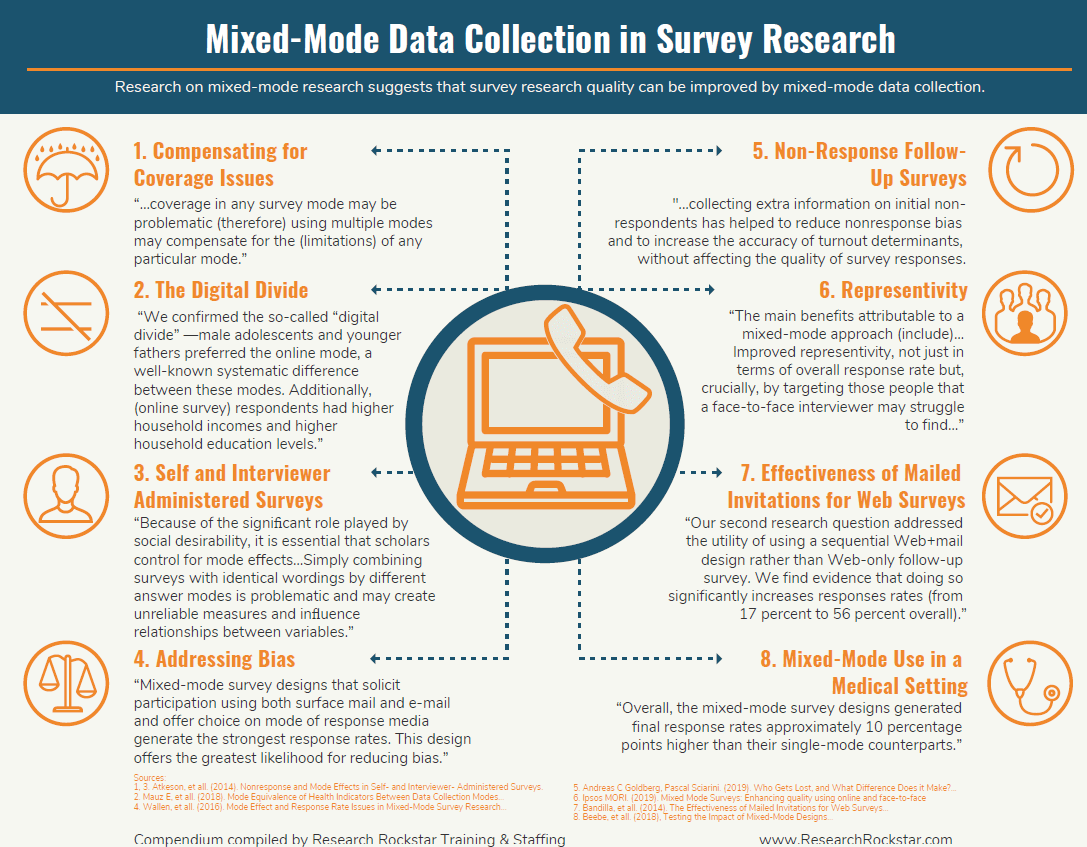
Benefits of Openchat for Businesses
Openchat offers a range of benefits for businesses looking to implement AI language models. These benefits include improved efficiency, enhanced customer service, and cost savings.
In addition, Openchat is designed for commercial use, making it an ideal choice for businesses. It offers a range of customization options, allowing businesses to tailor the model to their specific requirements and integrate it seamlessly into their existing systems.
Enhancing Customer Service with AI
Openchat provides businesses with the ability to enhance their customer service using AI-powered chat functionality. By leveraging the power of AI, businesses can automate customer support and provide real-time assistance to their customers. Here are some key ways Openchat can enhance customer service:
- Real-time assistance: Openchat can handle a large volume of customer queries and generate real-time responses, ensuring speedy and efficient customer service.
- Personalized responses: Openchat can understand user queries and generate personalized responses based on the context, providing a more tailored customer experience.
- 24/7 availability: Openchat is available round the clock, allowing businesses to provide customer support at any time of the day or night.
- Reduced wait times: With Openchat, customers no longer have to wait in long queues or on hold for customer support, leading to improved customer satisfaction.
Openchat’s AI-powered chat functionality can significantly enhance customer service, providing businesses with a powerful tool to automate tasks and provide personalized assistance to their customers.
Streamlining Operations and Reducing Costs
Openchat not only enhances customer service but also streamlines operations and reduces costs for businesses. Here are some key ways Openchat can help streamline operations and reduce costs:
- Automated tasks: Openchat can automate repetitive tasks, freeing up human resources to focus on more complex and value-added activities.
- Increased efficiency: By automating tasks, Openchat can significantly increase efficiency and productivity, allowing businesses to accomplish more in less time.
- Reduced staffing costs: With Openchat handling customer queries, businesses can reduce the need for large customer support teams, leading to cost savings.
- Improved resource allocation: Openchat’s AI-powered capabilities can help businesses allocate resources more effectively, ensuring optimal utilization and minimizing waste.
By streamlining operations and reducing costs, Openchat enables businesses to operate more efficiently and effectively, leading to improved profitability and competitiveness.
Openchat vs. ChatGPT
Openchat and ChatGPT are both powerful language models that offer businesses the ability to automate tasks and enhance customer service. Here’s a comparison of Openchat and ChatGPT:
- Performance: Openchat outperforms ChatGPT in terms of accuracy and contextually relevant responses.
- Customizability: Openchat offers greater customizability, allowing businesses to tailor the model to their specific requirements.
- Commercial use: Openchat is designed for commercial use, making it an ideal choice for businesses looking to implement AI language models.
- Integration: Openchat can be seamlessly integrated into existing systems, enabling businesses to leverage its capabilities without disruption.
When it comes to performance, customizability, and commercial use, Openchat offers businesses a compelling alternative to ChatGPT.
Benchmarking Performance and Accuracy
Openchat has been benchmarked for its performance and accuracy against other language models, including ChatGPT. Here are some key benchmarks:
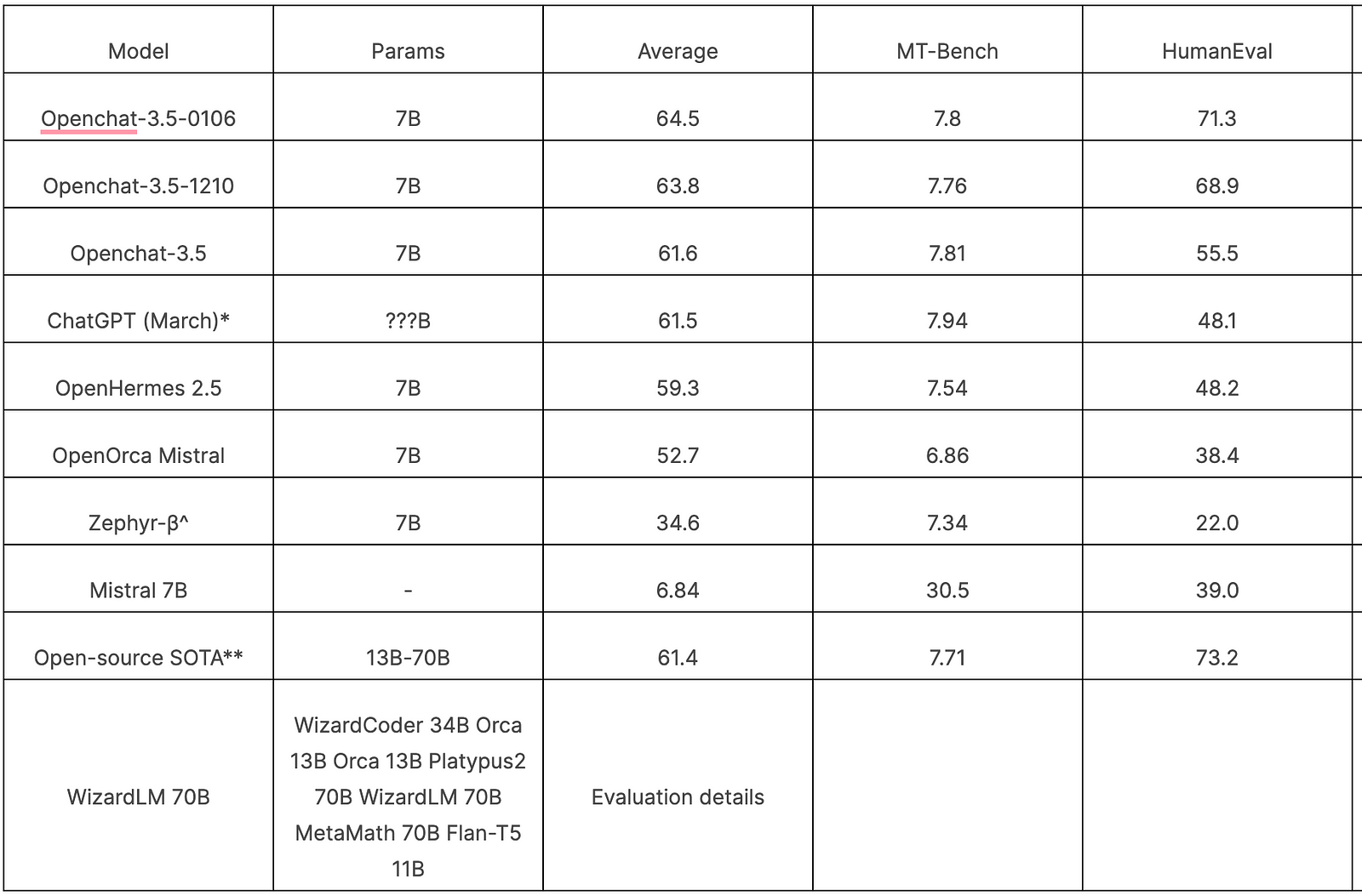
Evaluation details
- ChatGPT (March) results are from GPT-4 Technical Report, Chain-of-Thought Hub, and our evaluation.
- ^ Zephyr-β often fails to follow few-shot CoT instructions, likely because it was aligned with only chat data but not trained on few-shot data.
- ** Mistral and Open-source SOTA results are taken from reported results in instruction-tuned model papers and official repositories. All models are evaluated in chat mode (e.g. with the respective conversation template applied). All zero-shot benchmarks follow the same setting as in the AGIEval paper and Orca paper. CoT tasks use the same configuration as Chain-of-Thought Hub, HumanEval is evaluated with EvalPlus, and MT-bench is run using FastChat. To reproduce our results, follow the instructions below.
Openchat’s benchmarking performance showcases its accuracy and reliability compared to other language models. The model consistently performs well across various evaluation metrics, making it a top choice for businesses looking for high-performance language models.
Implementing Openchat in Your Business
Implementing Openchat in your business is a straightforward process that can bring numerous benefits. Here’s how you can integrate Openchat into your business:
- Assess your requirements: Identify the specific areas where you want to implement Openchat, such as customer service, content generation, or task automation. Determine the scope and scale of the implementation.
- Customize the model: Openchat is built on an open-source base model, allowing for easy customization. Tailor the model to your specific requirements, such as language, industry-specific terminology, and brand voice.
- Integration process: Integrate Openchat into your existing systems or develop new applications using Openchat’s API. Ensure seamless connectivity between Openchat and your business systems, such as customer relationship management (CRM) software or chat platforms.
- Train the model: Fine-tune Openchat using your own dataset or leverage the pre-trained models available. Train the model on your specific business domain to improve its accuracy and relevance.
- Testing and optimization: Test the integrated Openchat implementation thoroughly to ensure it meets your business requirements. Optimize the model based on user feedback and refine its performance as needed.
- Deployment and monitoring: Deploy Openchat into production and monitor its performance and user feedback. Continuously analyze and refine the model to improve its accuracy and user experience.
Integration Process and Best Practices
Integrating Openchat into your business requires careful planning and execution. Here are some best practices to follow during the integration process:
- Define integration requirements: Clearly define the integration requirements, such as the desired functionality, data sources, and system dependencies.
- Select the right server: Choose a server that can handle the expected workload and provide the necessary computational resources for running Openchat.
- Set up a gateway: Implement a gateway that allows for seamless communication between Openchat and your business systems, ensuring secure and efficient data transfer.
- Ensure data compatibility: Ensure that the data used by Openchat is compatible with the model’s requirements and format. Preprocess the data if necessary to ensure accurate and meaningful results.
- Monitor performance: Continuously monitor the performance of Openchat to identify any issues or bottlenecks. Regularly update the model and fine-tune it based on user feedback and evolving business needs.
By following these best practices, you can ensure a smooth integration process and maximize the benefits of Openchat for your business.
Navigating Limitations of Openchat
While the open-sourced model offers numerous advantages, particularly for highly targeted commercial applications, it’s not a universal solution. Compared to larger, closed models, such as ChatGPT, Openchat’s smaller training set may result in less refined outputs. Language limitations are also prevalent.
Deploying an open-source LLM also raises concerns about knowledge requirements. It often demands a thorough understanding of training and utilizing AI solutions, as well as substantial compute resources within the enterprise’s environment. In contrast, closed generative AI models are typically ready for use and integration with custom solutions right out of the box. Balancing considerations regarding commercial viability and resource constraints often dictates the appropriate choice of model.
On the other hand, private information cannot be guaranteed when you are using Open-sourced LLM. If you are looking for a safe, reliable and cost-effective close-sourced LLM, you can choose our LLM:
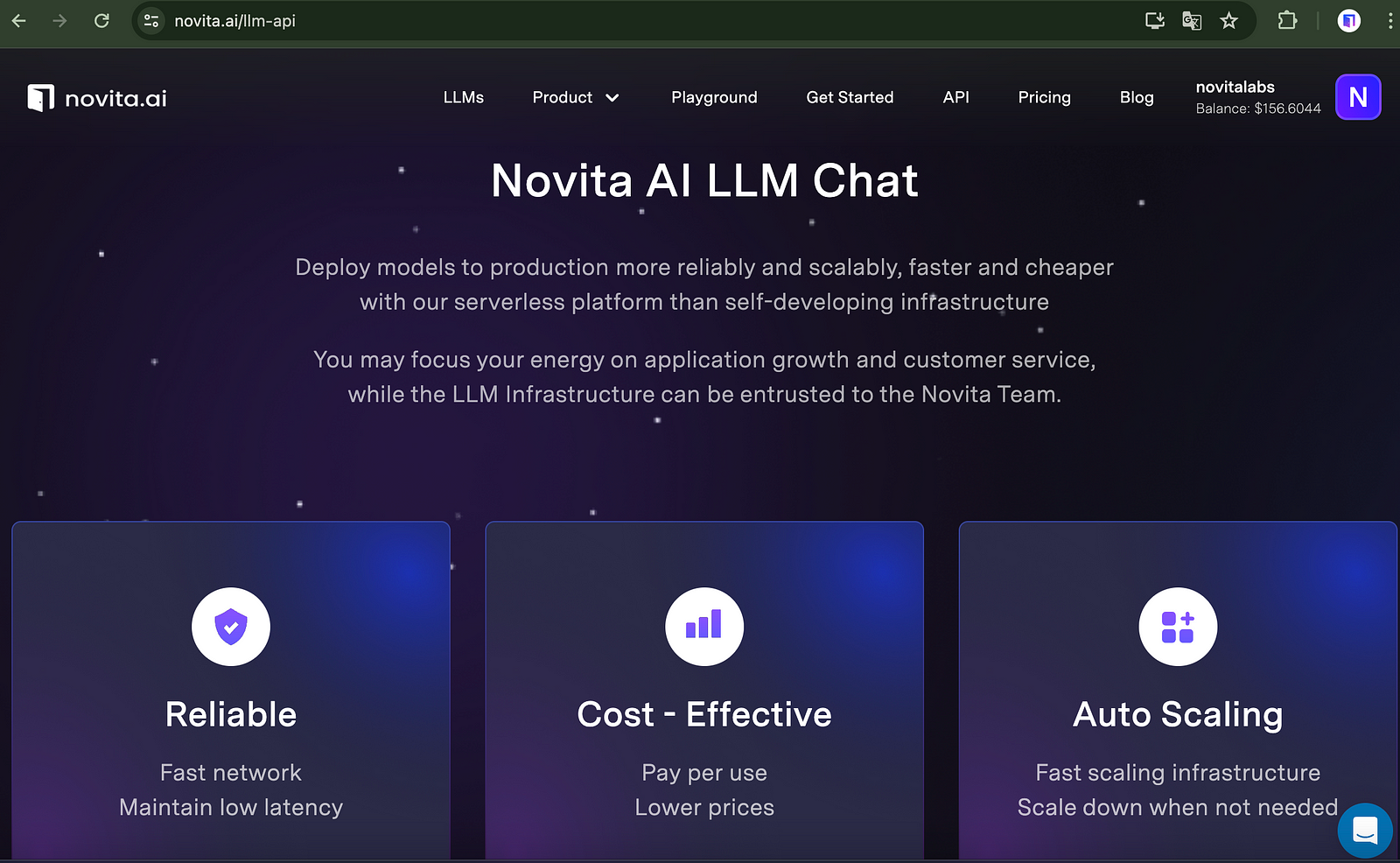
And we have already released LLM APIs, which can seamlessly integrate with your LLMs. With Cheapest Pricing and scalable models, Novita AI LLM Inference API empowers your LLM incredible stability and rather low latency in less than 2 seconds.
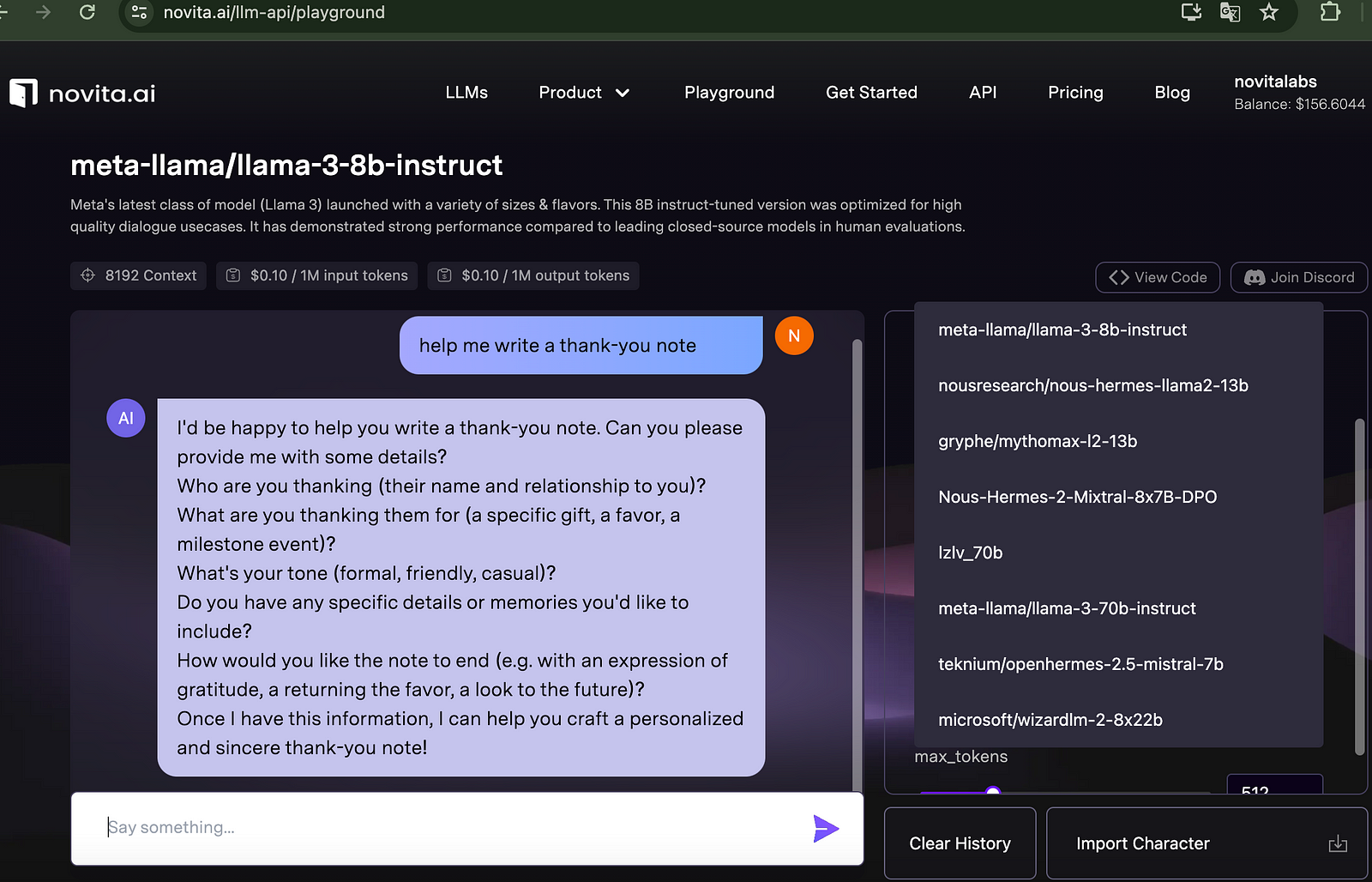
Our LLM API also features with character playing, by importing your favorite character card, you can talk anything with him/her.

The Future of Openchat and Open-source AI
Openchat and open-source AI have a promising future ahead. As technology continues to evolve, Openchat is expected to play a crucial role in shaping the future of language models and AI applications. Here are some key developments to look forward to:
- Ongoing developments: The development of Openchat is ongoing, with continuous updates and improvements being made to enhance its performance and capabilities. Expect to see regular updates and new features being introduced.
- Future plans: The roadmap for Openchat includes expanding its language support, improving model accuracy, and exploring new applications and use cases. Openchat aims to be at the forefront of AI language processing and generation.
- Community involvement: Openchat is driven by a vibrant and active community of developers and contributors. The community plays a crucial role in shaping the future direction of Openchat through collaboration and innovation.
- Advancements in open-source AI: Open-source AI is expected to witness significant advancements in the coming years. This includes the development of more powerful and efficient language models, improved model architectures, and enhanced customization options.
As Openchat and open-source AI continue to evolve, businesses can expect to benefit from even more powerful and customizable language models that can be seamlessly integrated into their operations.
Ongoing Developments and Future Plans
Openchat is continuously evolving, with ongoing developments and future plans to enhance its performance and capabilities. Here are some ongoing developments and future plans for Openchat:
- Model improvements: Openchat is constantly being fine-tuned and optimized to improve its accuracy, performance, and relevance.
- Expanded language support: Openchat aims to support a wide range of languages to cater to businesses operating in diverse regions and markets.
- Enhanced customization options: Openchat is exploring ways to provide businesses with even more customization options, allowing them to tailor the model to their specific requirements.
- Integration with emerging technologies: Openchat is actively exploring integration with emerging technologies like voice recognition and natural language understanding to provide businesses with even more advanced language processing capabilities.
The future plans for Openchat include continuous improvement and innovation to ensure that businesses can leverage the latest advancements in AI language models for their unique needs.
The Role of Community in Shaping Openchat
The Openchat community plays a crucial role in shaping the direction and development of the model. The community consists of developers, contributors, and users who come together to collaborate, share ideas, and contribute to the growth of Openchat.
The community actively engages in discussions, provides feedback, and shares insights on how Openchat can be improved and customized for various business applications. This collective effort helps shape the development roadmap of Openchat and ensures that it meets the evolving needs of businesses.
The community’s involvement goes beyond development, with initiatives like decentralized autonomous organizations (DAOs) and the Internet Computer Protocol (ICP) fostering decentralized governance and decision-making for Openchat. This community-driven approach ensures that Openchat remains an inclusive and accessible tool for businesses worldwide.
Conclusion
In conclusion, Openchat emerges as a groundbreaking open-source language model that revolutionizes business operations. Its C-RLFT strategy and utilization of mixed-quality data set it apart from other models, enhancing customer service and cutting costs. Implementing Openchat can streamline your business processes efficiently. The future looks promising with ongoing developments and community-driven shaping. Stay ahead in the AI game with Openchat’s innovative solutions and robust performance metrics.
Frequently Asked Questions
What makes Openchat different from proprietary models?
Openchat differentiates itself from proprietary models through its open-source nature. The model is released under an Apache license, allowing businesses to freely use and customize it. It is also built on the internet computer blockchain, providing added security and decentralization.
How does Openchat ensure data privacy and security?
Openchat ensures data privacy and security through various measures, including tokenization and encryption. User data is tokenized to protect sensitive information, and the model’s architecture includes encryption mechanisms to secure data transmission and storage.
novita.ai, the one-stop platform for limitless creativity that gives you access to 100+ APIs. From image generation and language processing to audio enhancement and video manipulation,cheap pay-as-you-go , it frees you from GPU maintenance hassles while building your own products. Try it for free.
Recommended reading
What is the difference between LLM and GPT
LLM Leaderboard 2024 Predictions Revealed
Novita AI LLM Inference Engine: the largest throughput and cheapest inference available